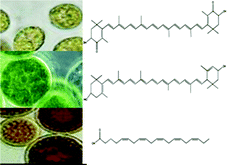New research by Food & Function Associate Editor Steven Feng Chen and co-workers describes the protective effects of certain microalgal strains against endogenous and exogenous advanced glycation endproducts (AGEs). AGEs are generated from the glycation between sugars and protein and can lead to the cross-linking of key molecules resulting in functional impairment. AGEs are believed to be important factors associated with the development of diabetic retinopathy – the leading cause of blindness in Western countries.
In this study, the extracts and active compounds of 3 microalgal strains (Chlorella zofingiensis, Chlorella protothecoides and Nitzschia laevis) were tested for their inhibitory effects on the glycation process in a cell based model. Results showed that astaxanthin, lutein and eicosapentaenoic acid (EPA) isolated from the microalgae reduced cell proliferation and the upregulation of both vascular endothelial growth factor and MMP2 mRNA, which are vital steps in the development of diabetic retinopathy. Therefore, these microalgal species can be regarded as beneficial foods for people suffering from diabetic retinopathy.
To find out more, read the article in full for free by following the link below:
Protective actions of microalgae against endogenous and exogenous advanced glycation endproducts (AGEs) in human retinal pigment epithelial cells
Zheng Sun, Jin Liu, Xiaohui Zeng, Jieqiong Huangfu, Yue Jiang, Mingfu Wang and Feng Chen
Food Funct., 2011, DOI: c1fo10021a











